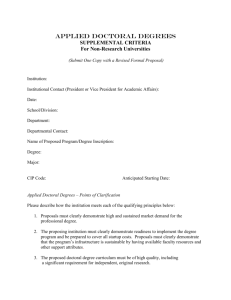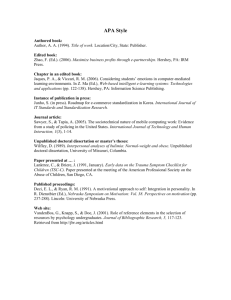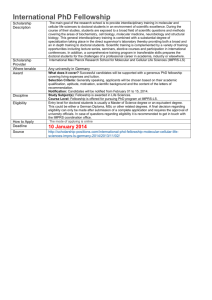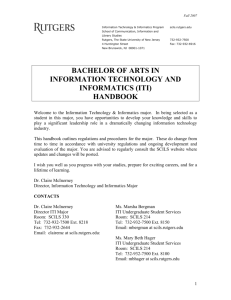PA1-2_iconf08
advertisement
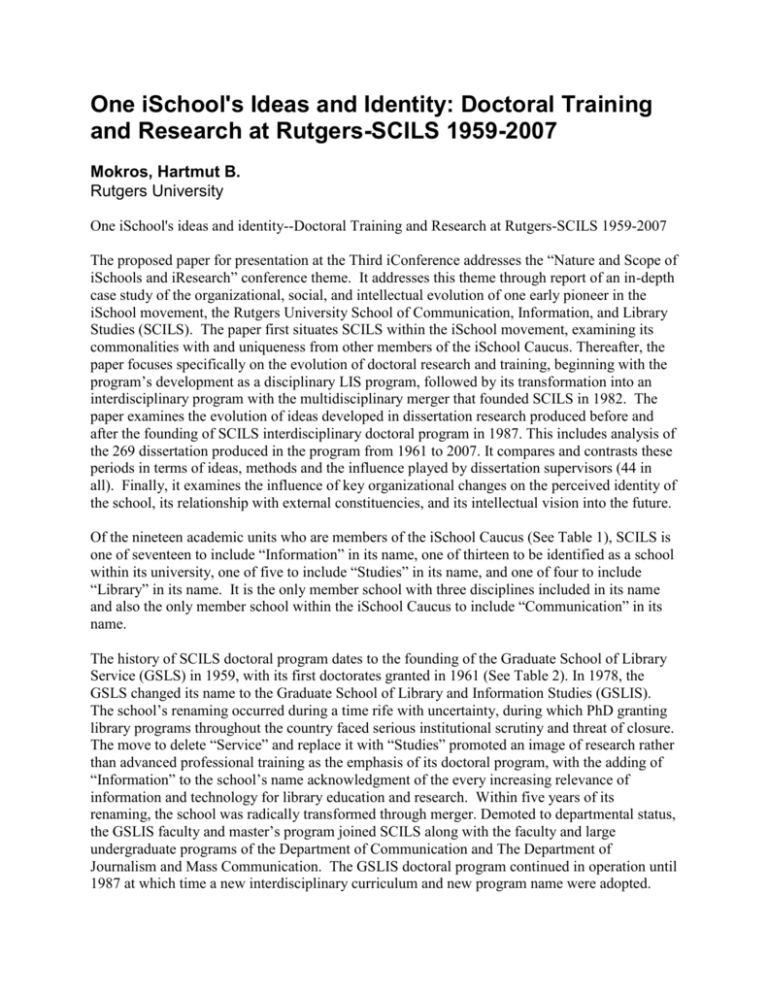
One iSchool's Ideas and Identity: Doctoral Training and Research at Rutgers-SCILS 1959-2007 Mokros, Hartmut B. Rutgers University One iSchool's ideas and identity--Doctoral Training and Research at Rutgers-SCILS 1959-2007 The proposed paper for presentation at the Third iConference addresses the “Nature and Scope of iSchools and iResearch” conference theme. It addresses this theme through report of an in-depth case study of the organizational, social, and intellectual evolution of one early pioneer in the iSchool movement, the Rutgers University School of Communication, Information, and Library Studies (SCILS). The paper first situates SCILS within the iSchool movement, examining its commonalities with and uniqueness from other members of the iSchool Caucus. Thereafter, the paper focuses specifically on the evolution of doctoral research and training, beginning with the program’s development as a disciplinary LIS program, followed by its transformation into an interdisciplinary program with the multidisciplinary merger that founded SCILS in 1982. The paper examines the evolution of ideas developed in dissertation research produced before and after the founding of SCILS interdisciplinary doctoral program in 1987. This includes analysis of the 269 dissertation produced in the program from 1961 to 2007. It compares and contrasts these periods in terms of ideas, methods and the influence played by dissertation supervisors (44 in all). Finally, it examines the influence of key organizational changes on the perceived identity of the school, its relationship with external constituencies, and its intellectual vision into the future. Of the nineteen academic units who are members of the iSchool Caucus (See Table 1), SCILS is one of seventeen to include “Information” in its name, one of thirteen to be identified as a school within its university, one of five to include “Studies” in its name, and one of four to include “Library” in its name. It is the only member school with three disciplines included in its name and also the only member school within the iSchool Caucus to include “Communication” in its name. The history of SCILS doctoral program dates to the founding of the Graduate School of Library Service (GSLS) in 1959, with its first doctorates granted in 1961 (See Table 2). In 1978, the GSLS changed its name to the Graduate School of Library and Information Studies (GSLIS). The school’s renaming occurred during a time rife with uncertainty, during which PhD granting library programs throughout the country faced serious institutional scrutiny and threat of closure. The move to delete “Service” and replace it with “Studies” promoted an image of research rather than advanced professional training as the emphasis of its doctoral program, with the adding of “Information” to the school’s name acknowledgment of the every increasing relevance of information and technology for library education and research. Within five years of its renaming, the school was radically transformed through merger. Demoted to departmental status, the GSLIS faculty and master’s program joined SCILS along with the faculty and large undergraduate programs of the Department of Communication and The Department of Journalism and Mass Communication. The GSLIS doctoral program continued in operation until 1987 at which time a new interdisciplinary curriculum and new program name were adopted. The interdisciplinary program established in 1987 has gone through significant changes in the years since. Most significant has been the program’s reorganization from a five to a three area of specialization model in 1999. This change occurred shortly after two of the school’s three departments modified their departmental names. Having removed “Service” in favor of “Studies” in 1978, prior to the merger with SCILS, LIS now removed “Studies” replacing it with “Science.” The change of name to the Department of Library and Information Science acknowledged the departments increasing intellectual ties with and hires of computer science and engineering faculty. At this same time, with LIS moving closer to the physical sciences, Journalism shifted its future toward the humanities, and away from the social sciences, symbolically expressed through the erasure of “Mass Communication” from its departmental in favor of “Media Studies.” Although Communication did not pursue a change of name for its department, it greatly focused its curriculum, research and hiring around three areas: social interaction, organizational communication, and mediated communication focusing especially on the development of strength in health communication linked to these areas. The proposal and adoption of a new three area model for the PhD program further supported a rising sense of departmental autonomy in pursuit of research and the training of doctoral students. The new model aligned each of the school’s three departments with one area within the program: Communication Processes, Library and Information Science, and Media Studies. In the years since the adoption of the three area model has SCILS doctoral program has been remarkable productive in its inclusion of new faculty supervisors and in the number of dissertations completed annual. And yet despite its productivity old tensions have emerged. Those tensions reveal the conundrums faced by a multidisciplinary school whose disciplinary pulls and alternative interdisciplinary partnerships have begun to offer more attraction and reward than another round of collective sense making to secure the commons of an i-dentity.
